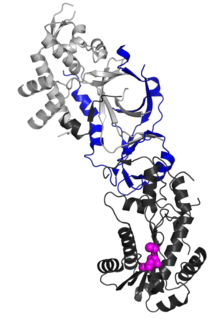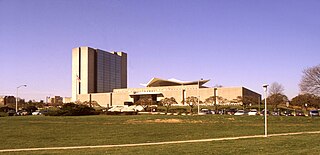
Deoxyribonuclease I, is an endonuclease coded by the human gene DNASE1. DNase I is a nuclease that cleaves DNA preferentially at phosphodiester linkages adjacent to a pyrimidine nucleotide, yielding 5'-phosphate-terminated polynucleotides with a free hydroxyl group on position 3', on average producing tetranucleotides. It acts on single-stranded DNA, double-stranded DNA, and chromatin. In addition to its role as a waste-management endonuclease, it has been suggested to be one of the deoxyribonucleases responsible for DNA fragmentation during apoptosis.

Acid alpha-glucosidase, also called α-1,4-glucosidase and acid maltase, is an enzyme that helps to break down glycogen in the lysosome. It is functionally similar to glycogen debranching enzyme, but is on a different chromosome, processed differently by the cell and is located in the lysosome rather than the cytosol. In humans, it is encoded by the GAA gene. Errors in this gene cause glycogen storage disease type II.

Cathepsin A is an enzyme that is classified both as a cathepsin and a carboxypeptidase. In humans, it is encoded by the CTSA gene.

Membrane-bound transcription factor site-1 protease, or site-1 protease (S1P) for short, also known as subtilisin/kexin-isozyme 1 (SKI-1), is an enzyme that in humans is encoded by the MBTPS1 gene. S1P cleaves the endoplasmic reticulum loop of sterol regulatory element-binding protein (SREBP) transcription factors.

Putative P2Y purinoceptor 10 is a protein that, in humans, is encoded by the P2RY10 gene.

G-protein coupled receptor family C group 5 member B is a protein that in humans is encoded by the GPRC5B gene.

Deoxyribonuclease gamma is an enzyme that in humans is encoded by the DNASE1L3 gene.

Deoxyribonuclease-1-like 1 is an enzyme that in humans is encoded by the DNASE1L1 gene.

Group XV phospholipase A2 is an enzyme that in humans is encoded by the PLA2G15 gene.

Gamma-interferon-inducible lysosomal thiol reductase is an enzyme that in humans is encoded by the IFI30 gene.

V-type proton ATPase subunit C 2 is an enzyme that in humans is encoded by the ATP6V1C2 gene.

Di-N-acetylchitobiase is an enzyme that in humans is encoded by the CTBS gene.

ATPase, H+ transporting, lysosomal 38kDa, V0 subunit d2 is a protein in humans that is encoded by the ATP6V0D2 gene. It is part of proton pumps in the plasma membranes of osteoclasts and aids with extracellular acidification in bone resorption.

Transmembrane protein 200A is a protein that in humans is encoded by the TMEM200A gene.

Solute carrier family 7, member 14 is a protein that in humans is encoded by the SLC7A14 gene.

Ribonuclease H2 subunit C is a protein that in humans is encoded by the RNASEH2C gene. RNase H2 is composed of a single catalytic subunit (A) and two non-catalytic subunits, and degrades the RNA of RNA:DNA hybrids.

Lysosomal protein transmembrane 4 alpha is a protein that in humans is encoded by the LAPTM4A gene.

Late endosomal/lysosomal adaptor, MAPK and MTOR activator 4 is a protein that in humans is encoded by the LAMTOR4 gene.

Deoxyribonuclease 2 beta is a protein that in humans is encoded by the DNASE2B gene.

Single-stranded DNA-binding protein 4 is a protein that in humans is encoded by the SSBP4 gene.























